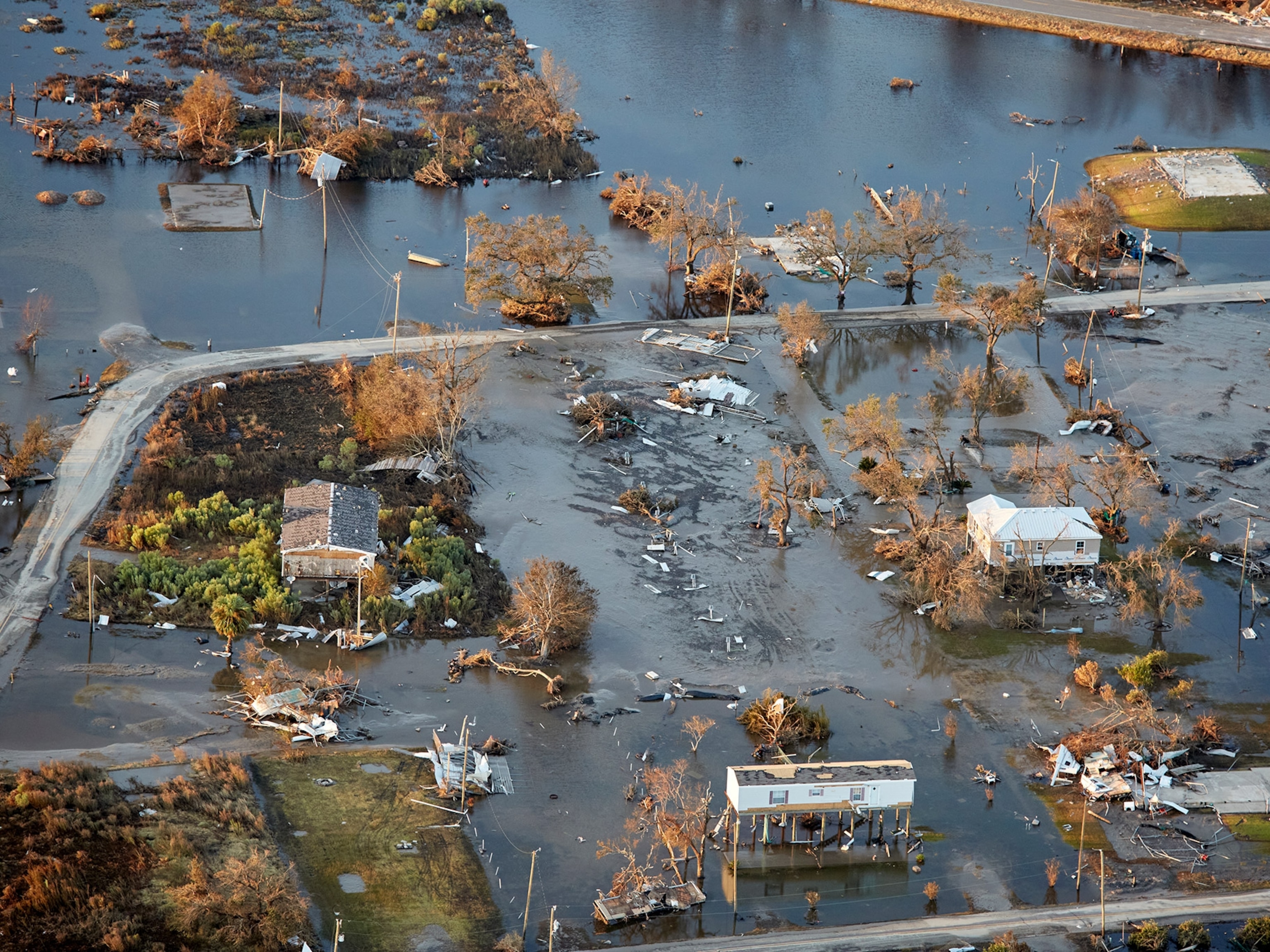
Summer storms can strike suddenly. Here’s what causes them.
Hot, humid weather can create the perfect conditions for a surprise afternoon storm—but where and when those occur may change as the planet warms.
For many of us, warmer months are a time to relax, spread out in the warm sun, and maybe have a picnic. But who among us hasn’t experienced the dread of seeing storm clouds form as if out of nowhere in the hot afternoon, followed by a mad scramble for cover as a thunderstorm suddenly strikes?
Why do storms always seem to strike so much more frequently in the summer?
The simple reason is that summer weather often provides the perfect conditions for storms to develop. Warm temperatures allow the atmosphere to hold more humidity, and that humidity is a prerequisite for building clouds—specifically, the tall, menacing cumulonimbus clouds that produce thunder and lightning.
But that’s not true everywhere. And as climate change makes the world increasingly hotter, some parts of the country are seeing more of that stormy weather.
How hot weather cooks a storm
As the hot sun heats the ground, the air above it naturally rises until it clashes with a higher layer of cold air, creating atmospheric instability—the necessary component for a thunderstorm.
With the pump thus primed, all that is needed is a trigger, something that causes the warm air to keep rising. That can be, for example, a front—which is essentially a collision between two masses of air—or a mountain range creating a barrier that forces the air upward.
As the warm, humid air continues to rise, the cumulonimbus clouds grow ever bigger, reaching farther upward until the moisture droplets turn to particles of ice that bounce off each other, creating electrical charges that eventually discharge as bolts of lightning, which heat and expand the surrounding air to produce thunder. Only about 10 percent of lightning flashes reach the ground; the rest are discharged from cloud to cloud.
Worldwide, there are an estimated 16 million thunderstorms each year, with about 2,000 in progress at any given moment. There are approximately 200,000 annually in the U.S. alone, and about 10 percent of storms are classified as “severe”— featuring hail at least one inch in diameter or winds at least 58 miles an hour.
Where are summer storms most common?
According to Matthew Elliott, a meteorologist at the the National Weather Service’s Storm Prediction Center in Norman, Oklahoma, there are several different areas in the U.S. where thunderstorms are particularly prevalent and frequently severe.
One is along the mid-Atlantic seaboard down to the Gulf states, where storms are fed by warmth and by the readily available moisture from the Atlantic Ocean and Gulf of Mexico.
Another is just west of the Rockies, in the higher elevations of California and Colorado, where the mountains force heated air to rise, causing thunderstorms almost daily and particularly in the afternoon after storm conditions have had a chance to build.
Conversely, in some parts of the country, conditions conspire to suppress storms for long stretches during the summer. Over large swaths of Texas and Oklahoma, “it's very hot and humid, but you're not getting the daily thunderstorm activity,” says Elliott.
The reason, he says, is that a layer of warm air, generally traveling north from the northern plateaus of Mexico, acts as a “lid” that prevents the lower, heated, unstable air from rising and colliding with the cold air above. Because the regional topography is generally flat, “we don't have a lifting mechanism in the area, per se,” to help break through that lid, he explains. Storms often detour around that lid of warm air and form instead along its northern periphery, in places such as Kansas and North Dakota and east along the Ohio Valley.
And while Oklahoma is of course no stranger to severe storms—being the global epicenter of tornados and related superstorms— the peak season for those events is typically April and May, before the summer warm air “lid” settles into place.
This, of course, doesn’t mean that Oklahomans don’t have to worry about hail or thunderstorms in summer, or that “wetter” states never experience dry spells.
Elliott emphasizes that “severe weather can happen anywhere, anytime, but there are certain peak areas and peak seasons.”
What impact will climate change have?
Whether these patterns will hold as climate change distorts weather patterns is unclear.
Given that warmer air can hold more moisture, a heated planet is likely to produce rainier weather when storms do occur. One recent study found that, under projected warming scenarios, the eastern seaboard of the U.S. might face up to nine more days of storms, while the Southwest could see an increase in the heavy lid of hot air that suppresses them.
Elliott, however, is keen to point out that weather events happen on very small scales, compared to the large expanse of global climate change, and small perturbations in the local environment can affect if and how storms develop, making it difficult to precisely predict changes.
“It's not as simple [to predict] as for hurricanes, flooding, or fires,” he says. “The relationships [with a changing climate] are just not as straightforward.”
In general, however, he says it is reasonable to assume that storms will occur with greater frequency in areas and at times that have generally been considered on the fringes of their reach— after summer’s peak and into fall, or farther north than usual, for example. He cites by way of example the fact that December 2021 saw tornadoes strike in both Minnesota and Kentucky, well outside their most common range and time period.
The biggest difference, however, will likely be that an already chaotic system will become more so, and unpredictability will increase.
That might mean, for example, that areas that typically do not see severe summer storms very often may start to. Equally, areas that commonly experience a few severe storms each summer may become milder.
“We have like 50-60 years of solid data in total, but the first 50 years of it aren’t as consistent as the last 10,” he explains. “So, I think that over the next five to 10 years, we're going to be able to say a lot more as we begin to better to better understand what the changes are likely to be.”
Related Topics
You May Also Like
Go Further
Animals
- How can we protect grizzlies from their biggest threat—trains?How can we protect grizzlies from their biggest threat—trains?
- This ‘saber-toothed’ salmon wasn’t quite what we thoughtThis ‘saber-toothed’ salmon wasn’t quite what we thought
- Why this rhino-zebra friendship makes perfect senseWhy this rhino-zebra friendship makes perfect sense
- When did bioluminescence evolve? It’s older than we thought.When did bioluminescence evolve? It’s older than we thought.
- Soy, skim … spider. Are any of these technically milk?Soy, skim … spider. Are any of these technically milk?
Environment
- Are the Great Lakes the key to solving America’s emissions conundrum?Are the Great Lakes the key to solving America’s emissions conundrum?
- The world’s historic sites face climate change. Can Petra lead the way?The world’s historic sites face climate change. Can Petra lead the way?
- This pristine piece of the Amazon shows nature’s resilienceThis pristine piece of the Amazon shows nature’s resilience
- Listen to 30 years of climate change transformed into haunting musicListen to 30 years of climate change transformed into haunting music
History & Culture
- Meet the original members of the tortured poets departmentMeet the original members of the tortured poets department
- Séances at the White House? Why these first ladies turned to the occultSéances at the White House? Why these first ladies turned to the occult
- Gambling is everywhere now. When is that a problem?Gambling is everywhere now. When is that a problem?
- Beauty is pain—at least it was in 17th-century SpainBeauty is pain—at least it was in 17th-century Spain
Science
- Here's how astronomers found one of the rarest phenomenons in spaceHere's how astronomers found one of the rarest phenomenons in space
- Not an extrovert or introvert? There’s a word for that.Not an extrovert or introvert? There’s a word for that.
- NASA has a plan to clean up space junk—but is going green enough?NASA has a plan to clean up space junk—but is going green enough?
- Soy, skim … spider. Are any of these technically milk?Soy, skim … spider. Are any of these technically milk?
Travel
- Dina Macki on Omani cuisine and Zanzibari flavoursDina Macki on Omani cuisine and Zanzibari flavours
- How to see Mexico's Baja California beyond the beachesHow to see Mexico's Baja California beyond the beaches
- Could Mexico's Chepe Express be the ultimate slow rail adventure?Could Mexico's Chepe Express be the ultimate slow rail adventure?







